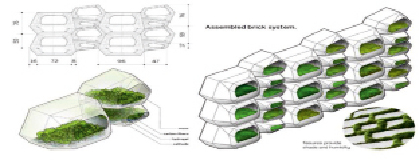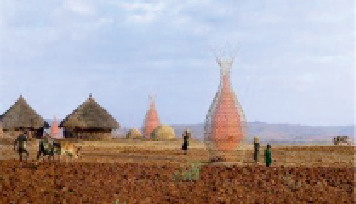The current interest in the problem lies in the fact that nowadays «green technologies» have become very popular. The use of energy efficient systems and construction of «green» buildings are quite relevant and developed abroad. These technologies and the idea to save natural resources itself have become a lifestyle for thousands of people who care about nature. In Russia green buildings structures are being promoted primarily as a fashionable trend, «ecological responsibility» which was given publicity. The authors note that «green» technologies allow using less energy, so it is possible to save natural resources and limit the quantity of greenhouse gases emission. Sergey Donskoy, the Minister of Natural Resources and Environment of the Russian Federation, stresses: «Implementation of «green» technologies is one of the guarantees of sustainable and long-term growth of the economy» [1]. The Russian market has been rapidly developing in this field. Green technologies have become available even for people with average income. Unfortunately, information about «green» systems is rather limited in Russian magazines, so the authors have studied some foreign resources and ready to represent some of the most popular «green» technologies used.
There are a big number of common architectural actions essential to reach sustainable architectural goals. Some of them are: environmental protection, preservation of cultural values and human lifestyles, optimization of natural and artificial resources, reduction of wastes and power consumption etc. Some actions are extremely efficient and cost-effective while the others are extremely costly. Evidently, the ideal objective would be the construction of all the buildings with the highest level of sustainability, at the least possible economic cost. Based on the mentioned above it is important to select the most economically efficient, architecturally sustainable actions, within the certain frame budget. These actions must be classified in terms of economic cost and environmental efficiency. There are 38 established sustainable indicators used to calculate the environmental efficiency of each action.
American scientists in UCLA invented the way of carbon dioxide production based on the constructions similar by its characteristics to the concrete. Carbon dioxide exhausts from electro stations are used as the main component of the green concrete. New material is called CO2NCRETE (the combination of the carbon dioxide formula – (CO2) and the word «concrete»). What is important, the production of traditional concrete produces about 5 % of total word carbon dioxide pollution. The scientists believe the green concrete will lower the air pollution level because during its production there are no toxic wastes, as well as refined carbon dioxide production. Due to this invention the new application method of stored carbon dioxide has been found. Some experimental samples of green concrete were produced in universities’ labs nowadays. The mixture of carbon dioxide and chalk was placed in a 3d printer to make the final product. Furthermore, the inventors plan to set up the mass production of co2ncrete.
Next year Bio Mason Company will release to the market eco-friendly growing clean bricks. Since 2012 this start up from North Carolina has already made a breakdown in the field of construction materials. The technology of growing the bricks from sand and bacteria, developed by them, does no harm to the environment because there is no need to bake bricks in oven. Nowadays the demand for eco-friendly building materials is constantly growing; so these bricks with minimum carbon trace can take a significant part of eco-sustainable construction market. In 2013 the company has won the prize of 56 hundred thousand dollars on Postcode Lottery «Green Challenge». Since that time the engineers in Darem have been running the pilot factory, producing 1500 bricks a week. As well as the traditional bricks, made of sand, they require calcination during 3-5 days. Аs a result of it every year approximately 8000 mln tons of CO2 get released into the atmosphere. Growing bio bricks from bio mason costs 2-3 mln tons. According to the company’s announcement, the bricks also absorb harmful substances, improving the eco climate [2].
Transparent wood. Swedish researchers from the King’s technical institute have created the innovative material – transparent wood. With the use of this material the constructions that don`t block the natural sunlight can be built. During this research the scientist removed lignin which is a part of all plants. This structure polymer holds approximately 95 percent of the sunlight. But after removal of this polymer lumber it remains opaque, later transformed to the white mass. To achieve the shallow effect the wood was polymerized by methilacrilate, as a result a wood veneer with Plexiglas was created. During this process the given structure remained still. New material became shallow and twice as strong as Plexiglas [2].
Cocoa fiber is an innovative multifunctional material of the 21th century. The material made of cocoa is applied as an insulant for the roofs, walls, partitions, ceilings and the floors. Some stuffing for the mattresses, furniture, rope products are made of cocoa fiber. There are plenty of areas where the cocoa fiber is used. Fiber is high-tensile, waterproof material which doesn’t mould due to the high concentration of lignin. The insulant made of cocoa fiber helps to keep the required microclimate parameters in the room. This material absorbs and releases moisture without the loss of thermal properties. Besides, cocoa insulant is a very good sound isolating material.
Natural insulant «Bauplit Cocos» consists of 85 % cocoa fiber and 15 % polyester binders that have no toxic compounds dangerous for the man’s health. The technology of producing cocoa insulant has several stages. At the first stage mixed fibers are melted by the airflow according to the air lay technology. Then the stuff comes through an oven where it is disinfected and the layers are stacked together by the warm airflow (according to the Green herm technology). The last stage is pressing the ready material into the sheets. The production process complies with the International System of quality assurance ISO-2001 requirements. It should be mentioned that installation of the heat insulator demands no additional instruments, tools or methods of protection.
Energy moss
International group of engineers has created the fotohalvanic battery that produces energy just using an ordinary moss. However, a mossy panel is not power capable and currently able to charge only a few LED-lamps simultaneously. Nevertheless, the researchers continue to upgrade it.
One of the researchers is Elena Mitrofanova [3], postgraduate of MARCHI and Catalonia Institute of Progressive architecture. Elena with her colleagues has designed energy saving facade of a building sphere where the electricity is produced via ordinary moss.
The designs of Elena Mitrofanova were embodied in the model that consists of several hollow cell-modules, installed into a facade system (fig. 1). The cells of the facade are made of ceramics, the bottom of each cell is glazed and the rest of the space is filled up with some porous clay.

Fig. 1. Energy moss concept

Fig. 2. Principles of energy moss

Fig. 3. Warka Water towers accumulating water from the air
Moss, growing in the cells starts to produce organics with the help of the sunlight. These organics come into soil where they are refined by bacteria. During this process, bacteria produce free electrons, which start the reaction with the soil that consists of hydrogel and carbon fibers (fig. 2). In this case the amount of generated electricity is approximately 0,4-0,5 Volt. Elena said that after the upgrade procedure the facade could be competed with the facades running on batteries. These panels can work in different climatic zones where sunlight for solar batteries is limited. Besides, the moss facade is more ecologically friendly and efficient, and able to regenerate.
Speaking about the solar batteries, the Chinese scientists from the Oceanic University have invented the solar batteries that accumulate energy even under the rain. The reflecting surface of these solar batteries is covered by a thin graphene layer. The graphene nanolayer consists of bivalent type of carbon, which atomic particles are connected with each other and form up in the shape of honeycombs. According to the announcement of these scientists, it is possible to receive such type of graphene layer by simple process of combustion, exfoliation and recovery of graphite. The function of the graphene is to protect the binding cations and electrons in rainwater. Each raindrop that falls to the graphene is filled up with positive ions while free electrons in the graphene layer appear. The condensate consisted of a double layer of electrons and positively charges ions, creates the voltage and as a result the conditions for energy production are generated [3].
Also it should be mentioned that using energy efficient technologies is very update. Speaking about usage of double facades with the natural ventilation, the income period is approximately 15 years but they are much asked. The facades consist of two layers of glazing and have flexible sections, controlled by the system of automatic. When there is a wind, and at a certain outdoor temperature the systems helps to ventilate and air the facilities without using the mechanic ventilation or air control systems. All these can save electrical and heat supply. However, these technologies are expensive to maintain and are being used mostly in the western business centers [4; 5].
The Italian architects have won the «World Design Impact Prize» for the design of a tower consuming no energy while accumulating water from the air.
Warka Water tower is designed by the architects from «Architecture and Vision» bureau especially for the poorest districts of Africa. Therefore, the authors have limited the total cost of the construction up to 1000 USD. Warka Water Towers is very efficient according to the authors’ estimation. It’s capable to produce approximately 100 liters of pure drinking water in 24 hours. The device is designed of bamboo twigs and pellucid net stretched inside. The condensate (dew and mist drops as well as rainwater) is accumulated on the net. Then the fluid comes into the reservoir. The foreign researches have tested the prototypes of the tower in Africa and it appeared that the most efficient construction has 3,7 meters in diameter and 9,5 meters in height. It can be constructed by ten people. The mass production of draining towers is scheduled in Africa for the next three years.
In conclusion it should be noted that the use of energy moss and solar panels will allow the engineers to save on electricity. The use of carbon dioxide concrete and eco-growing bricks will clean the air. The installation of Warka Water tower will let you accumulate water from the air and the technology of transparent wood will let you have sunlight and natural light in your house. All these innovative technologies will improve the ecological situation in the place where you live, protect the environment, modify your lifestyle, optimize the use of natural recourses and save money on your household bills. It follows logically from what has been said that green technologies are up to date and the use of these technologies has risen dramatically. This is the fundamental basis of the modern approach to provide the high quality structures and ecologically friendly environment. The given problem requires further study and careful development.
Библиографическая ссылка
Крыласова Е.A., Смирнова Е.В. «ЗЕЛЕНЫЕ ТЕХНОЛОГИИ» В АРХИТЕКТУРЕ // Международный студенческий научный вестник. – 2017. – № 4-6. ;URL: https://eduherald.ru/ru/article/view?id=17555 (дата обращения: 23.04.2024).

